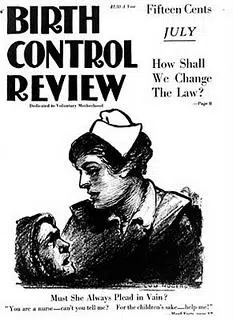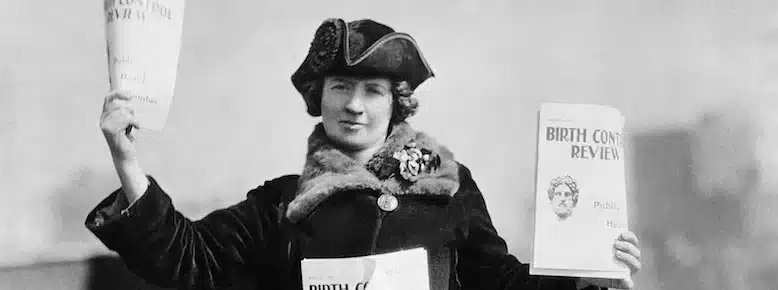Margaret Sanger and the KKK
The adage “A picture is worth a thousand words” is especially relevant in the case of a photo taken of Margaret Sanger giving a speech to the Ku Klux Klan in Silver Lake, New Jersey in 1926. The authenticity of the photo is debated, but what is beyond question is that Sanger’s deeply held racist and eugenicist views, though mostly hidden by the mainstream media, are alive and well today. In fact, Sanger was proud of these beliefs and freely wrote about and promoted them. She is the founder of Planned Parenthood, a billion dollar-a-year business and the largest abortion provider in the United States. It is largely responsible for the decimation of the African American population across America.
In Sanger’s work An Autobiography: A Fight for Birth Control, she writes about her experience at the KKK rally:
Always to me any aroused group was a good group, and therefore I accepted an invitation to talk to the women’s branch of the Ku Klux Klan….My address that night had to be in the most elementary terms, as though I were trying to make children understand. In the end, through simple illustrations I believed I had accomplished my purpose. A dozen invitations to speak to similar groups were proffered.1
The media has tried to excuse Sanger of moral misconduct by claiming, “[The KKK] was almost a mainstream group, if still clandestine” at the time. However, the entire passage describing her experience makes clear Sanger was very much aware and fearful of the organization’s history of violence. Still, she considered it useful to preach sterilization to all groups of people.
It should not be surprising that Sanger accepted the invitation, since her beliefs in regards to race superiority aligned perfectly with those of the KKK.
White Supremacy: Founding Principle of Planned Parenthood
White supremacist ideas drove Sanger’s efforts to limit the reproduction of the so-called unfit through sterilization, birth control, and abortion. The weak-minded, the mentally defective, and those affected by poverty served solely as a scapegoat2 since many African American communities suffered from unemployment, poverty, and crime.
Her philosophy was principally centered along racial lines, not social or economic concerns: “I accepted one branch of this philosophy, but eugenics without birth control seemed to me a house built upon sands. The eugenicists wanted to shift the birth control emphasis from less children for the poor to more children for the rich…. We sought first to stop the multiplication of the unfit.”3
Thomas Robert Malthus, a 19th century cleric and economist, strongly influenced Sanger’s worldview. In his famous work An Essay on the Principle of Population, Malthus writes: “All children born, beyond what would be required to keep up the population to a desired level, must necessarily perish, unless room is made for them by the deaths of grown persons…. We should facilitate, instead of foolishly and vainly endeavoring to impede, the operations of nature in producing this mortality.”4

Thomas Malthus
Malthus alleged that poverty, starvation, and all social ills are consequences of unrestricted population growth. Therefore, he viewed charities and philanthropic efforts as self-defeating and ultimately, exacerbating the problem of over-population by not allowing nature to take its course and eradicate those suffering from the effects of poverty.
The influence on Sanger is unmistakable, and in her political essay The Pivot of Civilization, she repeats Malthus’ ideas on the uselessness of charitable organizations:
Organized charity itself is the symptom of a malignant social disease. The vast, complex, interrelated organizations aiming to control and to diminish the spread of misery and destitution and all the menacing evils that spring out of this sinisterly fertile soil, are the surest sign that our civilization has bred, is breeding and perpetuating constantly increasing numbers of defectives, delinquents, and dependents…. The most serious charge that can be brought against “benevolence” is that it encourages the perpetuation of defectives, delinquents, and dependents.5
The aims recommended by Sanger were much more ambitious than those endorsed by the majority of eugenicists in the 20th century. Her ideology targeted minorities, more specifically African American families, which were known to have many children. In 1930, the American Birth Control League (ABCL) founded the Harlem Clinic, a precursor to the Negro Project, which would be introduced ten years later. It was established in the poor African American neighborhood of Harlem, New York at the dawn of the Great Depression.
The Harlem Clinic operated by offering “better health” to the community through contraceptives. However, Sanger understood suspicions would arise in regards to the clinic’s presence and its stated goals. Therefore, a plan was drafted to combat distrust within the community. Individuals in positions of social power within the African American community were paid to speak about the benefits of birth control and family planning. In a letter to Dr. Clarence Gamble—eventual regional director for the Birth Control Federation of America—Sanger writes about using influential African American community members to clear up any confusion.
We should hire three to four colored ministers, preferably with social-service backgrounds and with engaging personalities. The most successful educational approach to the negroes is through religious appeal. We don’t want word to go out that we want to exterminate the negro population. The minister is the man who can straighten out that idea if it ever occurs to any of their more rebellious members.6
Over the years, the meaning of this letter has been intensely debated. Her supporters argue it proves she did not want to eliminate the African American community and her critics point out that she simply wanted to keep this unspoken goal hidden. However, Sanger’s many writings, letters, and speeches and the voices she supported in her magazine, Birth Control Review, make clear her desire to control and limit the growth of the African American population.
In 1939, the Negro Project was founded by the Birth Control Federation. It was the culmination of Sanger’s vision for the African American community. It expanded on the work of the Harlem Clinic by providing contraception to African Americans in the South. However, the African American community was not responsive to the message of family planning. The BCFA faced resistance from community members who considered birth control fundamentally immoral and believed it similar to abortion.7 Once again, Sanger used powerful African American individuals to convince their communities that birth control would help them escape poverty.
I note that you doubt it worthwhile to employ a full time Negro physician. It seems to me from my experience where I have been in North Carolina, Georgia, Tennessee and Texas, that while the colored Negroes have great respect for white doctors they can get closer to their own members and more or less lay their cards on the table which means their ignorance, superstitions and doubts. They do not do this with the white people and if we can train the Negro doctor at the Clinic he can go among them with enthusiasm and with knowledge, which, I believe, will have far-reaching results among the colored people.8
Final Thoughts
Today, the goals and vision of Margaret Sanger are effectively advanced by Planned Parenthood. According to the most recent census data, African Americans make up only 13% of the United States population, but 40% of all abortions in the U.S. are performed on African American women. Despite assertions to the contrary and many catchy slogans, the philosophies of family planning and female empowerment are deeply rooted in racism. And the abortion industry is finally beginning to realize it cannot hide its association with a brutal eugenicist; it recently announced it would be removing Sanger’s name from its Manhattan abortion clinic.
A superficial ideological distancing is a dim but promising sign that public consciousness is awakening to the problematic roots of birth control and abortion in the United States.
+ Endnotes
[1] Sanger, Margaret. An Autobiography. New York: Dover Publications, 1971 (435-437).
[2] Sanger, Margaret. The Pivot of Civilization. Oxford: Pergamon, 1969 (25).
[3] Sanger, Margaret. An Autobiography. New York: Dover Publications, 1971 (446).
[4] Malthus, Robert. An Essay on the Principle of Population. 1st edition. Oxford University, 2008.
[5] Sanger, Margaret. The Pivot of Civilization. Oxford: Pergamon, 1969 (108-123).
[6] Sanger, Margaret. Letter to Dr. Clarence Gamble. 10 December 1939. Margaret Sanger Collection, Library of Congress.
[7] Ferebee, Dorothy. “Planned Parenthood as a Public Health Measure for the Negro Race.” Annual Meeting, Birth Control Federation of America. 29 January 1942.
[8] Sanger, Margaret. Letter to Dr. Clarence J. Gamble. 10 December 1939. Margaret Sanger Collection, Library of Congress.















Yeah. I read and did research. She made a clear distinction between sterilization for the elimination of “unfit” traits (a troubling thought today, but there were a lot of troubling thoughts in the mainstream at that time), and for the purpose of eliminating races and religions. The two-sentence quotation from 1934 is ““I admire the courage of a government that takes a stand on sterilization of the unfit and second, my admiration is subject to the interpretation of the word ‘unfit.’ If by ‘unfit’ is meant the physical or mental defects of a human being, that is an admirable gesture, but if ‘unfit’ refers to races or religions, then that is another matter, which I frankly deplore.”
It is difficult for me to see that as a racist statement. Rather, definitely anti-racist.
Also, I note that you left out the part of that quotation about her talk to the Women’s Auxiliary of the KKK where she said it was “one of the weirdest experiences I had in lecturing.”
And if she were racist, I doubt that she would have had any success in working with WEB DuBois.
Since you have a stated bias against abortion, I shan’t ague that against you. But painting Margaret Sanger as a racist is is disingenuous and misleading.
Sanger wanted to limit the growth of the black population. That is what we Know . More through sterilization and contraceptive. She appeared as a guest at kkk rallies. That’s a fact . Please read and research before you donate to planned Parenthood and stop killing babies.
Please explain how a photoshopped image of Margaret Sanger is damning.
BTW, you do know Sanger was not a racist and was opposed to abortion.